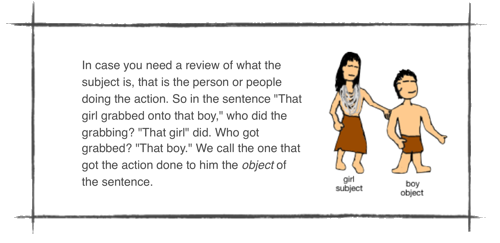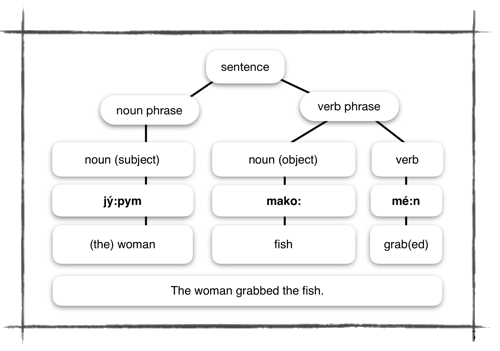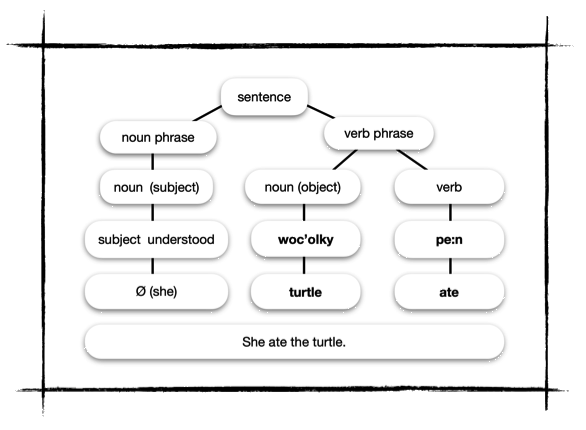This lesson is to help a learner be able to make very simple sentences in Konkow. These are the type of sentences you would make when you are describing something you did or are doing, or when you are telling a story. Fluent speakers rarely make their sentences simple! But as beginners, this is the best way to get started.
Suffixes are meaningful pieces added after noun or verb roots. The dash in front is the standard way of showing they are suffixes. When we analyze a word we will show dashes between the parts of the word.
Just as there are different kinds of words and components, there are also different kinds of sentences. You learned how to make one kind of sentence in the previous lesson - commands. This lesson is about statements - the kind of sentence you find in stories, or when you are telling about something that happened. Just like commands, a statement in Konkow can be as short as one word - a verb. (A verb is a word about doing something.) This is a possible sentence in Konkow:
That’s a complete sentence, even though it is only a verb. Actually, who released who is not clear from the sentence itself. It could also mean “He released her,” “She released it,” and so on. The reason we wrote “They released him” is because it is a sentence out of the story, Coyote and the Turtle Girls, and it was previous sentences that made it clear, that it was the Turtle Girls who released Coyote.
Coyote had been under water with the Turtle Girls for a while,
and he was running out of breath.
So he exclaimed “Let me go for a little while!”
The girls said “all right.”
só:n. “They released him.”
So you can see that unlike English, a Konkow sentence doesn’t have to have pronouns or nouns in every sentence. Here are some more verbs – each of them work as a whole sentence. There is an -n at the end of the verb in each case. We call that -n the “verb final.”
k’útumbùmbukk’ajehsám’an
(he/she) went about hunting, they say.
Note: -sámʔan, at the end of this last verb, means “they say,” and is common in story-telling. This is the first word in the story “Coyote and the Turtle Girls.”
We wrote these sentences as being in past tense. Sentences like these are usually translated as past tense in the stories, but in the right context, they could be about the present as well. On its own, mé:n could translate “(he) grabbed it” or “(he) grabs it”.
Of course to make sense when you talk about something, you really do have to communicate who is doing the action, and without context a verb alone doesn’t have that information in it.
So let’s add some nouns to our simple sentences. Here is a list of nouns.
Remember, the “it” in the English is there in some of these sentences because English always has to have a noun or pronoun; but you don’t have to include it in Konkow. And we don’t have to say “the” in Konkow, either.
The sentences below have words from the above two lists. Say the sentences below out loud and figure out what they mean:
Now translate the following sentences into Konkow. Just say the sentences out loud, don’t bother writing them if you don’t want to. (And remember, the “it” in the English is there in the second and third sentences because English always has to have a noun or pronoun; but you don’t have to include it in Konkow. And we don’t have to say “the” in Konkow, either.)
jý:pym k'útumbùmbukk'ajehsám’an.
The woman went about hunting (they say).
Since word order is variable,
it would be unusual but not wrong to put the
noun after the verb.
Notice that all the nouns above end in -m. That -m is to mark the noun as the one that did the action. We call the one that does the action the subject of the sentence.

Usually the subject comes before the verb. But notice that sometimes the subject comes after the verb, as in the first sentence from The Turtle Girls story:
Hover over the parts of the sentence below to reveal the sentence parts.
went about hunting
Old Man Coyote
The “object” of a verb is the thing or person that the action is done to.
woman
fish
grab

Practice what you have learned with these exercises.
What are some of the differences you notice between how you say this sentence in English and how you say it in Konkow?
jý:pym mako: mé:n.
The woman grabbed the fish.
- English has to have “the” in front of each noun; Konkow does not.
- In English the object follows the verb; in Konkow it precedes the verb.
- In Konkow, this sentence could translate either as “The woman grabbed the fish” or “The woman grabs the fish.” The English sentence is clearly in past tense.
- Konkow doesn't use capital letters; English does.
You may have come up with other kinds of differences too!
Now translate the following sentences into Konkow. Just say the sentences out loud, don’t bother writing them if you don’t want to. (And remember, the “it” in the English is there in sentences c and d because English always has to have a noun or pronoun; but you don’t have to include it in Konkow. And we don’t have to say “the” in Konkow, either.)
Since word order is variable,
it would be unusual but not wrong to put
the noun after the verb.
Either the object or the subject can also be understood in the context of a story or conversation.
(She)
the turtle
ate
“(She) ate the turtle.”

The -i object suffix disappears after a word that ends in a vowel, because you can't have two vowels in a row in Konkow. That's why wóc’olky doesn’t have an -i at the end in the sentence above even though it's the object of the sentence.
Review what you have learned in this lesson about making words and sentences in Konkow.
- 1. A Konkow sentence can be as short as a single word (a verb). Either the subject or the object, or both, can be understood through the context of a conversation or story.
- 2. Typically a sentence ends in a verb, though word order is flexible.
- 3. The noun referring to the subject (the actor) of the sentence has the suffix -m (-im). The suffix is -m when the noun root ends in a vowel, and -im when the noun root ends in a consonant. Another way to show this kind of suffix is this: -(i)m.
- 4. The object (the thing acted upon) of the sentence is marked by the suffix -i when the noun root ends in a consonant, and by nothing when the noun root ends in a vowel.
- 5. One way to think about the disappearing i is to realize that in Konkow you cannot have two vowels in a row. So if, for example, the root ends in the vowel and is followed by a suffix that starts with one, then one of the vowels has to “go away.”
Review what you have learned with flash cards. Throughout these lessons, we use a standard layout, which can be easily cut on any paper cutter. First cut the paper lengthwise. Then cut the two rectangles in half. The four rectangles are cut in half once more. Once you know those three measurements, all the flashcards are cut the same way.
Want to learn more? All the Mary Jones videos lessons are available HERE
